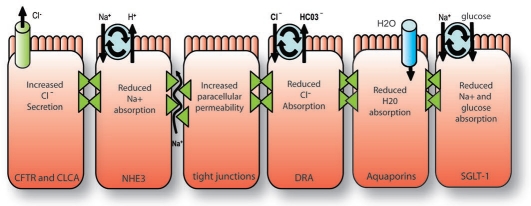Figure 1.
An overview of general mechanisms causing diarrhea. At the most basic level, diarrhea is caused by increased secretion or decreased absorption of fluids and electrolytes. Certain ion transport processes are particularly associated with diarrhea. These include CFTR and CLCA, which are chloride channels and the Na+/H+ exchange isoform, NHE3, which is involved in Na+ absorption. Alterations in tight junctions create an important pathway for the movement of both ions and water. DRA is responsible for chloride absorption and is associated with congenital chloride diarrhea. Data on aquaporins is limited but they are expected to contribute to diarrhea when absorption is reduced. SGLT-1 transports sodium and glucose and is tightly coupled with water movement and is the basis for oral rehydration using glucose to enhance sodium absorption.

